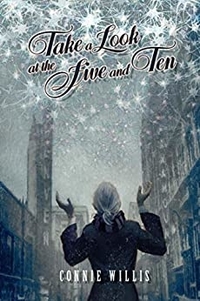
Published by Subterranean Press on November 30, 2020
Take a Look at the Five and Ten is both a Christmas story and a love story. I’m not a fan of either genre but I’m a huge fan of Connie Willis. She is known for her science fiction, typically involving time travel or an historical setting. Take a Look at the Five and Ten involves science and history but it’s more of a mystery than science fiction.
The mystery resides in an old woman’s memory of a seasonal job she held at Woolworth’s when she was nineteen. The woman is Grandma Elving, who is actually the grandmother of Dave’s fourth wife. Dave likes to host holiday dinners. In addition to Elving, this year's attendees include Dave's current wife Jillian, Jillian's daughter Sloane, Aunt Mildred, who is related to Dave’s second wife, and Ori, whose mother was briefly married to Dave at some point in his chain of failed marriages. Ori narrates the story. Dave seems like a decent fellow, Ori is meek but pleasant, and Elving is sweet, although nobody wants to listen to her talk about Woolworth’s. Sloan, Jillian, and Mildred are all the kind of relatives who make people dread holiday dinners.
Grandma Elving has spent years boring her relatives with stories about Woolworth’s. It’s all she ever talks about. Everything reminds her of it. When Sloan brings her boyfriend Lassiter to Thanksgiving dinner, Lassiter is fascinated by the Woolworth’s story. He’s researching a phenomenon called Traumatic Flashbulb Memory. He’s sure that Elving suffered a trauma that caused her brain to capture all the surrounding circumstances while repressing the traumatic event. Lassiter wants to test his theory by testing Elving as she recounts all the details of her memory, which Elving is only too happy to do. Ori is only too happy to help Lassiter, despite her lack of interest in the Woolworth’s stories, because she quickly develops a thing for Lassiter.
The mystery surrounds the nature of the trauma that triggered Elving’s flashbulb memory. Whenever Elving seems to get close to recalling it, the memory slips away, leaving her to talk about Woolworth’s Christmas decorations and the perfume counter and her co-workers and whatever other Woolworth’s-related stories pop into her head. She happily goes on field trips with Ori and Lassiter (or sends them off to look for the nativity figures she’s always talking about) as they try to prompt her repressed memory.
Lassiter’s research eventually takes him in an unexpected direction that he can’t easily accept. That’s human nature. When data isn’t consistent with our theories, we cling to the theories and blame the data. But scientists need to be better than that. They need to abandon bad theories or revise them to account for nonconforming data. That ongoing process is what science is all about. (It should be what thinking is all about, yet a large body of people prefer to dismiss reliable data as “fake news” when it disproves a false conclusion that they find comforting.) Using the tools of a masterful storyteller, Willis makes that point without ever saying it out loud.
The novella-length story touches upon issues that engender debate among philosophers and neuroscientists. Are negative emotions (such as fear and distress) stronger than positive emotions (such as joy)? Is there a difference between happiness and joy and, if so, is the difference only one of degree? Yet this is ultimately the story of two people who, while coping with annoying relatives, are drawn to each other as Christmas approaches. It doesn’t necessarily need to be read on a deeper level — as a Christmas love story, it’s sweet enough to star Tom Hanks and Meg Ryan in their younger days — but Willis offers greater depth for readers who want it.
RECOMMENDED